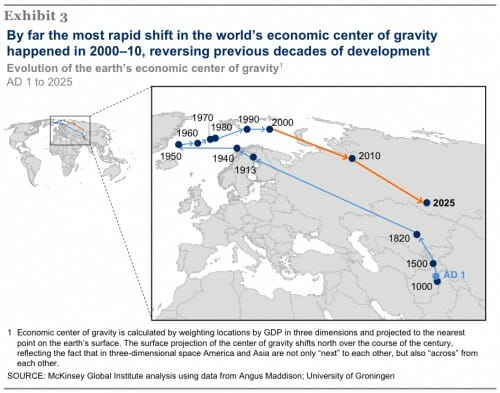It is Historically Unusual for China NOT to be the Largest Economy on Earth
A couple of quick thoughts on this map from this Vox article edited by Matt Yglesias
- I hate to diss my old cohorts at McKinsey, but isn't this entirely arbitrary to how you draw the map? If you made the map break in, say, the Atlantic Ocean with the Ivory Coast on the far left of the map and Newfoundland on the far right, won't this look different?
- People seem to want to get freaked out about China passing the US in terms of the size of its economy. But in the history of Civilization there have probably been barely 200 years in the last 4000 that China hasn't been the largest economy in the world. It probably only lost that title in the early 19th century and is just now getting it back. We are in some senses ending an unusual period, not starting one.

Re 1, no it wouldn't. If you read the footnote more closely, they calculate the 3D center of economic activity, which is inside the Earth, and then project that point out to the surface, so the projection and choice of 0 longitude doesn't matter. What would be more interesting would be how the radius of the center changed, since a single dominant economy would create a large radius, while a relatively equal amount of worldwide activity would create a smaller radius. Of course, the distribution of the landmass and the world's population means that the center will probably always be in the northern hemisphere between Portugal and Seoul.
It would be interesting to know how they assigned a position value to each GDP value: to the geographic center of each country, or to its economic center. The former would put Russia's mass out in the middle of Siberia rather than where it belongs, and would cause a similar problem with China. For the US, they probably aren't much different.
I think what many miss in this map is a very serious and disheartening trend, if the map is correct. It is not East West movement that has me interested but the remaining gap of North to south that has not shrunk at the same time. In my opinion this shows a serious growth problem in the southern hemisphere that seems to be lagging for a longer time and could be chronic...
Of course, like most international comparisons this is all just matching one set of government lies against a different set of government lies. GDP calculation is pretty much a joke in all of these countries.
I disagree about the usual times. When China was the largest economy in the world, it also was a very long duration trip from the west. Now it is a half-hour ICBM flight.
Focus on per capita GDP and you get an entirely different result.
According to this article http://qz.com/162690/why-china-cant-take-over-the-world/ this is a massive oversimplification and exaggeration of China's historical economic place in the world.
Not really, Max because this is GDP and not GDP per capita. Given that the majority of the world's land mass and therefore population is in the northern hemisphere, this doesn't tell us anything about standards of living in the south either in absolute terms or comparatively.
GDP per capita
http://www.globalsherpa.org/wp-content/uploads/2012/03/china-gdp-per-capita-20-centuries.gif
While the difference over most of history may seem small, the Chinese also had developed society to create much greater concentrations of people.
There's an interview from last week with Ambrose Evans Pritchard where he suggests china won't pass US this century,
http://youtu.be/a3tPljeiT-Y
Bogus comparison: if instead you compare China with The West, which stretches from Mesopotamia to the Atlantic, China has been behind for many more years that she has been ahead.
Pritchard...Pritchard... Isn't he the guy that wrote that wonderful introduction to a poetry textbook?
:-D
Exactly... Max, the equator runs through BRAZIL, which means it pretty much splits SouthAm in half, and through the southern edge of the horn of Africa, which means MORE than half of Africa's land mass lies above it.
So, in the Southern Hemisphere, you have half of one very large nation(Brazil), one other large nation (Argentina), Australia, New Zealand, and... what? Anything else of notable size, either economically or population-wise? South Africa, maybe?
And let's not forget that any "northern-southern" land mass comparisons include that vast enclave of human population, Antarctica. So there's really far LESS "land mass" in the Southern Hemisphere than you might think, in the sense that matters.
I think the eastern seaboard would still move it noticeably to the eastern side, But Cali and Seattle would certainly have a lot of counter weight to that.
Just looking, back-of-the envelope, probably within 100 miles of Nashvile, TN.
So Coyote, what's your take on this whole Xanterra vs NPS at the Grand Canyon? Looks X is deciding that its not worth keeping the contract and no other potential contractor is in a hurry to pay X the money the NPS owes it - especially with the 14% (vice 3.8% X had) cut the government wants now.
Here is a huge difference between America as the World Power and other historical situations: we want other nations to be prosperous.